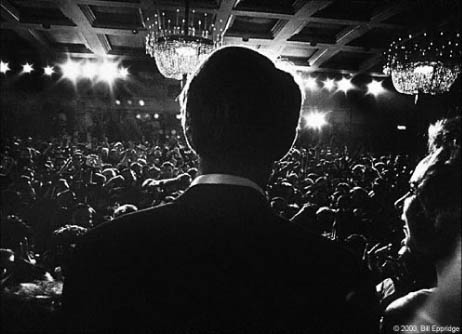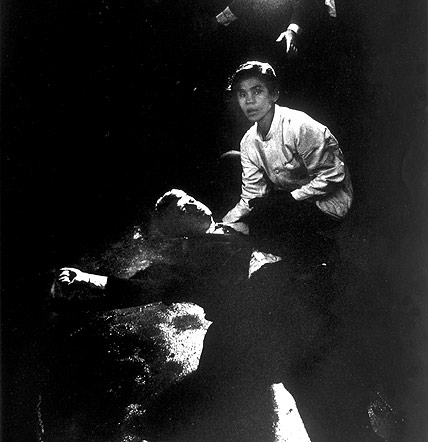JUNE 5 -- 1968
June 5, 2011 | Source: Monroe Gallery of Photography

Bill Eppridge: Bobby and Ethel face a jubiliant crowd in the ballroom of ther Ambassador Hotel after his victory in the California Primary, June 5, 1968 ©Time Inc.
Of course, every great photographer has that one picture, an icon, which sometimes even distracts attention from his other work. For Bill Eppridge that's the one taken in the early hours of June 5th, 1968.
After the campaigns of '66 and '68, in a time when there was no Secret Service protection for presidential candidates, when press contingents were small and access available for the asking, he could even call the senator a friend. So too did millions of Americans whose only connection to Robert Kennedy was that they saw in him hope for the future.
I well remember thinking how exciting it was for Bill and reporter Sylvia Wright to be so very close to RFK during that campaign. To me, he was "real" and he was young, and it was the first time I would be old enough to vote. Somehow he would deal with Vietnam and our recovery from Dr. King's assassination. He was the antidote to the spirit of disharmony so many of us felt.
The events in Los Angeles that day and the next are best told by Bill for there's the knowledge and a sensitivity that come with the intimacy of his experience.
At the home office here in New York it had been a fairly typical Tuesday evening. That meant that a respectable number of the Life staff were to be found in a local bar. The magazine closed on a Wednesday and so, while it may have been latish, it was early to go home, and we didn't have to return to work. It was easy to find volunteers to keep the bar open.
Successful at last negotiating my key into my apartment's lock, by now it was really quite late and I tried desperately not to disturb my roommate. But Susan was awake, not because of my antics but because of the horrific news from California. She welcomed me with: "Bobby has just been shot."

I'll never forget the way she screamed at me to get back to the office immediately. Obviously, in 1968, there were no cell phones, and they had frantically been trying to reach the bar-crawling picture department.
Gathered again somberly on the 29th floor, we shed our tears, but went to work quickly and professionally. We spent three days, 'round-the-clock, putting together the regular and a special issue. We had the convenience of office showers in those days and they, and the adrenaline, refreshed us. For the cover, we chose Bill's very serene and touching picture of Bobby running down the beach with his dog, Freckles; the assassination photograph went inside.
Bill's film had been processed in Los Angeles and, despite some pushing, needed further coaxing in our New York lab to produce the single print from which we could engrave. The negatives were handed to me for safekeeping, and I, discreetly, placed them under my large, and badly faded green desk blotter.
I wasn't the most obvious person for the two burly FBI agents to question about the whereabouts of the film when they hesitated at my desk, but my helpful and rather disingenuous "I know that whoever has the negatives will certainly help you gentlemen out by making really big prints for you to study" seemed to move them along. "We will obviously do whatever we can to cooperate, especially at a time like this."
The miniskirt too may have helped them believe in my innocence. But it was a different time: No cell phone, but a desk blotter, and even negatives. There was certainly no Department of Homeland Security. We were anxious to help, but with one negative, possibly the best lab in the country, and no such thing as a digital copy, we weren't taking a chance on losing that negative and its image.
Bobby lingered for almost 26 hours after the shooting, and Bill flew into New York, later meeting the senator's coffin at the airport, attending the service at St. Patrick's Cathedral, and being invited on to the funeral train to Arlington.
Bill and I spent a considerable amount of time together over that couple of days although it's difficult to calculate where those hours came from. My most vivid memory is of a quiet dinner shared, both crying and comforting one another. I was, and remain, in absolute awe of how he had the wits about him to capture so memorably that horrible moment. I asked him directly: "What was going on in your mind? Your dear friend had just been shot. How could you think that quickly under those circumstances?"
He explained - he talked about his reaction to the sound of the .22-caliber shots, and what he instinctively understood when he looked down at the man. There was nothing he could do to save him. There were plenty of other people to tend to him. So, his duty was to his profession, and, struggling to keep his emotions in check, he took one of the most significant photographs of the 20th century.
Many have described the picture as having a Pietà -like quality. Jack Newfield saw something religious too, and something more: "The expression on Robert Kennedy's face seems serene and accepting," he wrote, "his arms spread like Jesus on the Cross. The face of Juan Romero, a 17-year-old busboy who loved Kennedy and served him the night before, is shocked and appalled. Robert Kennedy's mood that last night was serene and liberated. The bullet arrived so swiftly it did not have time to alter the emotions Bob's face was reflecting in the final moments of his conscious life. Each time I see this photo I think it should be called 'History Slipping Through Our Fingers.' That's when history slipped through our fingers, leaving behind a photograph with its tragic traces of promises."
It's those promises that I have missed.
As is often said about the Sixties, they didn't end merely to conform with the calendar. By 1973, Life had ceased publishing as a weekly and Bill, after a short stint at People magazine, moved on to Sports Illustrated. "I wasn't shooting baseball, basketball or football," explains Bill, although of course he did shoot all three. "My motto is sports with no balls."
--Excerpted from "Bill Eppridge: A Personal Reflection on the Photographer in a Tumultuous Time"
June 2008
by Barbara Baker Burrows
via The Digital Journalist
Related: The burned master print of "Robert F. Kennedy Shot"
